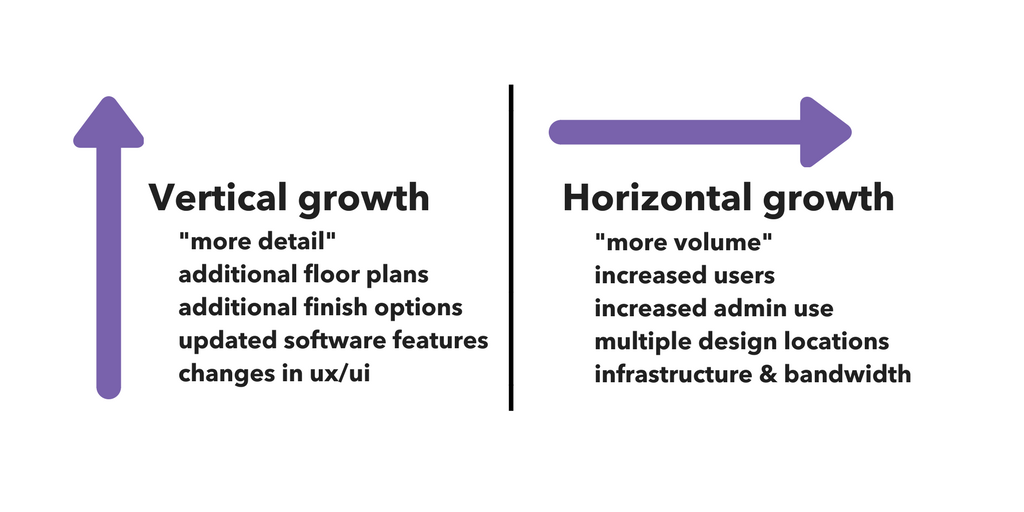In this episode of our transition to digital series, we’ll be discussing the concerns of scaling your technology. Anytime you are implementing a new technology or software for your business, the thought of scalability should be top of your list. Before we start however, let’s define scalability.
Two main types of growth or scale are vertical growth (beefing up your software; features, etc.) and horizontal growth (admin & user increased usage). With the growth of software use, IBM has defined 3 main parameters for success of a project: on schedule, on budget, and quality or functionality.
1. In-House or Use a Technology Partner?
When you’re looking at developing a software, a big question that will inevitably come up is whether or not you should build a team internally or outsource much of the development leg work. Do you have the team in place to handle a project of this caliber? Without the correct team you are looking at a high cost, low performing project, which is never good. A few question to consider for each option:
Inhouse
Being very honest with yourself as a decision maker and knowing the capacity of your current team could keep you from over-promising and under-delivering a final solution.
Ask yourself if your team currently has the people needed to complete this task or will you have to hire additional people. The hiring process alone can be very costly & lengthy, you may have to use a recruiter, or do rounds of interviews, etc. All of these should come into consideration with evaluating your current team and their capabilities.
Is this a one-off project or will you need a team to maintain the performance of this project over time. If you do not have the budget to hire the correct personel, how would this affect your current teams performance?
While percentages of failed IT projects has dramatically reduced over the last few years, there is still a significant chance of not performing to expectations. What would be the cost overall if the project does not work out? Is this project something your company can afford to take a loss on?
Use a technology partner.
A bad technology partner is the worst, make sure you hire the right team!
Once you’ve chosen to use an outside technology partner, it’s time to do your homework to make sure you are hiring the correct team. When choosing your technical partner it is so critical to do your due diligence, ask good questions, and be thorough:
Have you completed a project like this before?
Can you verify the work?
How will your team communicate with my team?
What measures do you have in place to assure quality control?
2. What does “Scaling” really mean?
Scalability is the capability of a system, network, or process to handle a growing amount of work, or its potential to be enlarged to accommodate that growth.
Scalability of a software can easily be viewed as how a software integrates and grows into your business operations. A software scales in two general directions; vertical growth, how detailed and demanding a software is to develop, and horizontal growth, the shear volume of administrative & customer usage.
Each one of these will come with its own set of issues, a few of those we will discuss with you below.

Vertical growth: “more detail”
As a home builder begins to add more floor plans, more finishes, etc., there will be changes in how your software will work.
Who is responsible for these updates and changes? If you do not have a well defined statement of work, you could find yourself paying for more work than you originally had in your budget.
What happens when you have updates to your original software, will these new integrations and updates work?
As consumer technologies change, how will these different mediums change the way you sell and market your homes?
Horizontal growth: “more volume”
Let’s say you finally get your software successfully developed and now it’s time to deploy this into a single or multiple locations, you have administration and customer user numbers growing, and also the hardware needed to properly use your software.
How many people will be using your software? As your user base grows, so does the infrastructure needed to maintain that software. Think of the hardware cost and the personnel needed to maintain them. If you have thought this through all of this will be properly added into your budget, if not, you may being finding unexpected cost keeping you from being able to truly grow the software the way you intended.
So how do you know if a project is successful?

What did Roomored do about it?
Leave the tech to us, we built a team for that.
Building an experienced and proven technical team has been a top priority since day one.
We have grown our team with decades of experience.
Roomored has put together a full technical team capable of handling all of the challenges of building your digital solutions. Our team has decades of experiences in areas of virtual reality, digital design, architecture, and video gaming. Your team will work directly with our project managers to make sure every single detail is met to exceed your expectations. We have refined our onboarding strategy to make sure that implementing our software is just as easy and using it is. We go through detailed training programs with your sales team to make sure your team fully understands how to maximize its use of the Roomored platform. Roomored is dedicated to delivering an excellent customer experience while serving as your trusted technology partner.
“ We knew what we were building was extremely complex, there are multiple moving parts that have to work together. So we made a decision that the core technology would be built in-house .”
-Farrukh Malik , Founder/CEO of Roomored

